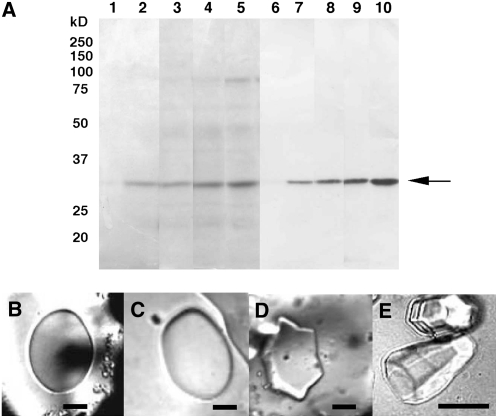Figure 2.
A, Coomassie Brilliant Blue-stained SDS-PAGE gels (lanes 1–5) and corresponding western blotting (lanes 6–10) of total proteins from culture media of bromegrass cells (wild type) exposed to low temperatures. Bromegrass cells were exposed to 15°C for a day (lanes 2, 7) and subsequently to 4°C for a day (lanes 3, 8), for 4 d (lanes 4, 9), and for 12 d (lanes 5, 10). Non-cold-treated samples were used as the control (lanes 1, 6). Twenty microliters of a 50-fold concentrated culture medium was applied to each lane. B to E, Induction of antifreeze activity in culture media of bromegrass exposed to low temperatures. Antifreeze activity was assayed by viewing the growth of an ice crystal formed in 50-fold concentrated culture medium. In these assays, the growth and morphology of ice crystals upon cooling were carefully observed. In the medium without antifreeze activity, flat round ice crystals grew rapidly. In the medium with antifreeze activity, ice crystal growth was retarded or arrested, and ice crystals showed specific shapes from flat hexagonal, hexagonal column to bipyramidal with increasing antifreeze activities (Hon et al. 1994). B, Before cold acclimation. C, At 15°C for a day then 4°C for a day. D, At 15°C for a day then 4°C for 5 d. E, At 4°C for 20 d. Bars = 50 μm.

